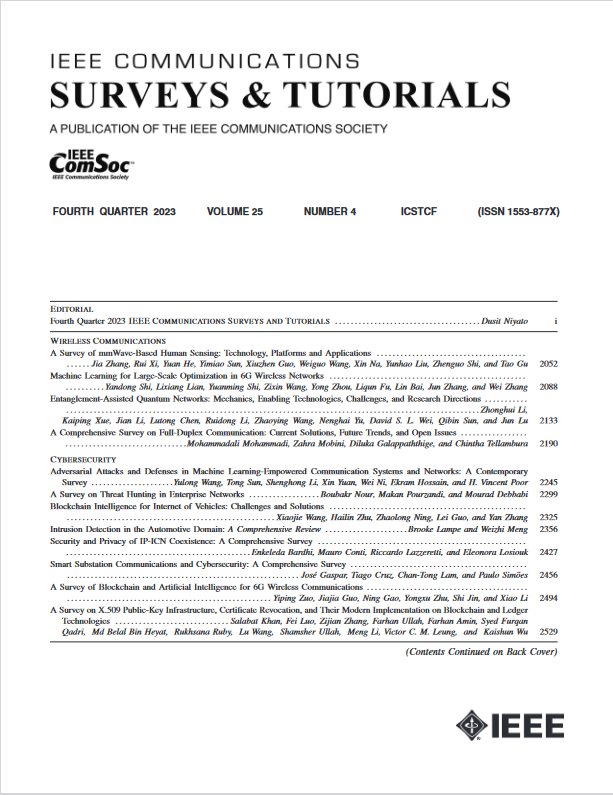A Tutorial on 5G Positioning
IF 34.4
1区 计算机科学
Q1 COMPUTER SCIENCE, INFORMATION SYSTEMS
引用次数: 0
Abstract
The widespread adoption of the fifth generation (5G) of cellular networks has brought new opportunities for the development of localization-based services. High-accuracy positioning use cases and functionalities defined by the standards are drawing the interest of vertical industries. In the transition towards the deployment, this paper aims to provide an in-depth tutorial on 5G positioning, summarizing the evolutionary path that led to the standardization of cellular-based positioning, describing the localization elements in current and forthcoming releases of the Third Generation Partnership Project (3GPP) standard, and the major research trends. By providing fundamental notions on wireless localization, comprehensive definitions of measurements and architectures, examples of algorithms, and details on simulation approaches, this paper is intended to represent an exhaustive guide for researchers and practitioners. Our approach aims to merge practical aspects of enabled use cases and related requirements with theoretical methodologies and fundamental bounds, allowing to understand the trade-off between system complexity and achievable, i.e., tangible, benefits of 5G positioning services. We analyze the performance of 3GPP Rel-16 positioning by standard-compliant simulations in realistic outdoor and indoor propagation environments, investigating the impact of the system configuration and the limitations to be resolved for delivering accurate positioning solutions.5G 定位教程
第五代(5G)蜂窝网络的广泛采用为本地化业务的发展带来了新的机遇。标准定义的高精度定位用例和功能引起了垂直行业的兴趣。在向部署过渡的过程中,本文旨在提供关于5G定位的深入教程,总结导致基于蜂窝定位标准化的演进路径,描述当前和即将发布的第三代合作伙伴计划(3GPP)标准中的定位元素,以及主要研究趋势。通过提供无线定位的基本概念、测量和架构的全面定义、算法示例以及仿真方法的详细信息,本文旨在为研究人员和实践者提供详尽的指南。我们的方法旨在将启用用例的实际方面和相关需求与理论方法和基本界限结合起来,从而理解系统复杂性与5G定位服务的可实现(即有形)利益之间的权衡。我们通过符合标准的模拟分析了3GPP Rel-16在真实的室外和室内传播环境中的定位性能,研究了系统配置的影响以及提供准确定位解决方案需要解决的限制。
本文章由计算机程序翻译,如有差异,请以英文原文为准。
求助全文
约1分钟内获得全文
求助全文
来源期刊

IEEE Communications Surveys and Tutorials
COMPUTER SCIENCE, INFORMATION SYSTEMS-TELECOMMUNICATIONS
CiteScore
80.20
自引率
2.50%
发文量
84
审稿时长
6 months
期刊介绍:
IEEE Communications Surveys & Tutorials is an online journal published by the IEEE Communications Society for tutorials and surveys covering all aspects of the communications field. Telecommunications technology is progressing at a rapid pace, and the IEEE Communications Society is committed to providing researchers and other professionals the information and tools to stay abreast. IEEE Communications Surveys and Tutorials focuses on integrating and adding understanding to the existing literature on communications, putting results in context. Whether searching for in-depth information about a familiar area or an introduction into a new area, IEEE Communications Surveys & Tutorials aims to be the premier source of peer-reviewed, comprehensive tutorials and surveys, and pointers to further sources. IEEE Communications Surveys & Tutorials publishes only articles exclusively written for IEEE Communications Surveys & Tutorials and go through a rigorous review process before their publication in the quarterly issues.
A tutorial article in the IEEE Communications Surveys & Tutorials should be designed to help the reader to become familiar with and learn something specific about a chosen topic. In contrast, the term survey, as applied here, is defined to mean a survey of the literature. A survey article in IEEE Communications Surveys & Tutorials should provide a comprehensive review of developments in a selected area, covering its development from its inception to its current state and beyond, and illustrating its development through liberal citations from the literature. Both tutorials and surveys should be tutorial in nature and should be written in a style comprehensible to readers outside the specialty of the article.
 求助内容:
求助内容: 应助结果提醒方式:
应助结果提醒方式:


